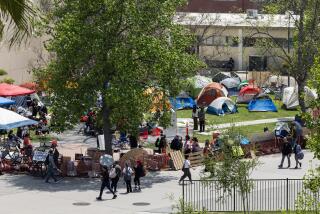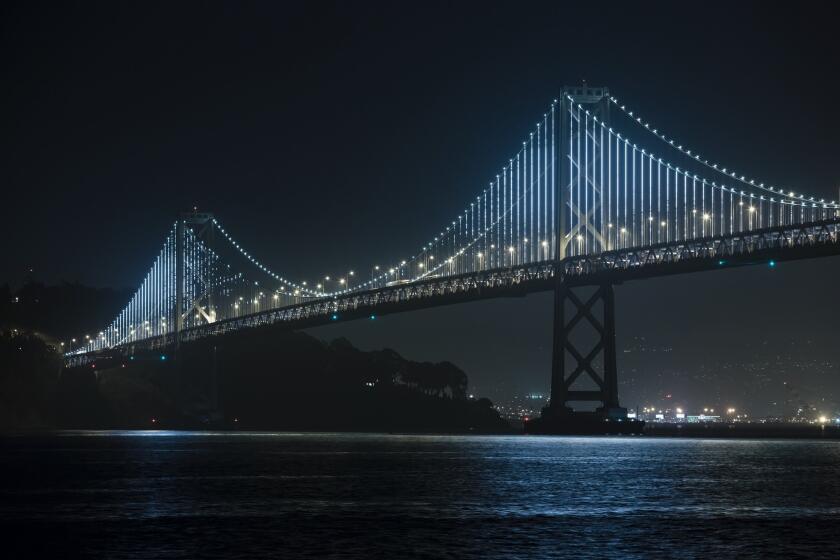L.A. RETHINKS OPEN DESIGN OF SUBWAYS
As Los Angeles transit officials pour millions of dollars into cameras and other high-tech security devices in the wake of 9/11, one major security gap persists: No one is stationed underground to help subway passengers in a crisis.
Unlike most U.S. subways, Los Angeles’ works on the honor system. There are no gates to pass through, no turnstiles that open when a fare is paid and no attendants -- let alone police officers -- stationed on the platforms.
Subway planners designed it that way, hoping the open feel would encourage riders in a place weaned on the automobile but also reduce operating costs.
But now -- after Metropolitan Transportation Authority officials were embarrassed by the botched response to a mercury spill that was left on a downtown platform in December for eight hours -- the look of Los Angeles’ subways might change.
There is growing discussion among MTA board members and other local officials about a major overhaul of how the stations work -- adding barriers and possibly gate attendants as well as more security officers. Some officials say the mercury incident proves that the agency’s reliance on closed-circuit cameras to show what’s going on underground is inadequate.
“If we go to gates, we would have a station attendant there all the time,” said Roger Snoble, the agency’s chief executive officer, who plans to present a report on the issue in the coming weeks. “They would be there to help keep an eye on things.”
Adding security personnel and MTA staff would change the atmosphere of the system as well as boost security. It would also be costly.
An MTA study produced last year found that hiring 500 instation attendants would cost $24 million annually. Installing turnstiles in the subway’s 16 stations would cost between $50 million and $150 million. To secure the subway, the report said, three attendants per shift would have to be added at each of the subway’s 54 entrances.
Some riders -- who are expected to buy tickets though usually they are not checked -- say they can go days without ever seeing a sheriff’s deputy or any uniformed transit workers on their trains or in stations.
Los Angeles County sheriff’s deputies patrol the subway, riding the rail lines among stations. About 100 deputies and uniformed fare inspectors patrol 73 miles of subway and light rail -- leaving parts of the system uncovered for long stretches.
Without full-time transit workers on site, passengers in an emergency must find an intercom to contact operators at a distant bunker. That is the only source of communication with the outside world. There are no pay phones in subway stations, and cellphones don’t work that far underground. (Other subway systems have paid to have their platforms wired for cellphone use but the MTA has not.)
Since 9/11, the MTA has touted its increased security measures, which focus largely on adding hundreds of closed-circuit television cameras to platforms and trains. Those efforts cost about $80 million a year.
Though security experts have praised the effort, they also say not having personnel in stations leaves vulnerabilities.
Experts say adding transit workers and law enforcement to Los Angeles’ subway stations would be a plus -- especially as the number of daily riders continues to increase. Ridership stands at nearly 250,000 weekday boardings for the entire rail system.
But they caution that it could give passengers a false sense of safety in the tunnels.
“It adds a level of security without saying that if you add people you will not have an attack,” said Anastasia Loukaitou-Sideris, chairwoman of UCLA’s urban planning department, who has studied transit terrorism around the globe.
Train bombers in London and Madrid killed hundreds after passing through turnstiles under the watchful eyes of gate agents in those stations, as did the attackers who released poisonous sarin gas in the Tokyo subway.
Loukaitou-Sideris and other experts say training employees to respond effectively in a crisis is more vital to passenger safety than where the workers are located.
“If you are going to have people, it’s important to have people who are trained and know how to respond appropriately,” said Martin Wachs, a transportation expert at Rand Corp.
Assigning transit and law enforcement personnel to stations would bring Los Angeles more in line with the rest of nation’s subway systems.
“Fixed posts at all stations would probably be a good thing,” said Sheriff’s Cmdr. Dan Finkelstein, who is in charge of transit services. “Any employee in that kiosk is a lot better than we have now.”
Washington, D.C., transit workers manning each of the 86 subway stations are responsible for visually inspecting the platforms and watching for suspicious activity.
In New York’s subway system, station agents staff information booths around the clock to assist passengers.
In Chicago, the system’s 21 subway stations are gated and customer assistants or security guards are present whenever the trains are running.
Security concerns led Dallas officials to assign transit police around the clock to their only underground light-rail station: Cityplace, north of downtown.
Most commuters would welcome the presence of transit workers as they wait for the train, especially at night.
“It would most definitely improve the situation,” said Leonel Perez-Roura, 33, of Glendale.
In an emergency, PerezRoura, a paralegal who uses the subway to get from courthouse to courthouse, said he would alert authorities using the emergency intercoms.
“They are supposed to be by the escalator or the fire extinguisher,” he said, looking around the Wilshire-Vermont station for one within eyeshot. There were three on the platform: one at each end and one in the center. No signs directed passengers to the intercoms.
Vickie Chatigny, 57, of Llano said she has determined how far up the escalator she must climb to get cellphone reception to contact authorities in a crisis.
“I know in situations you have to rely on yourself,” said Chatigny, a supervisor with Los Angeles County Superior Court. “I don’t think [transit officials] take security serious.”
Such sentiments are fueled in part by the MTA’s response in December when a man spilled mercury on the Pershing Square platform. After dumping the hazardous substance, he called the MTA operator on an intercom and reported what he had done. But for reasons that are not clear, no one came to investigate or clean up the spill.
Several train riders touched the substance before a passenger called police eight hours later. Hazardous materials crews eventually removed the mercury.
MTA officials acknowledged that their staff botched the response to the spill -- and this has prompted calls for major improvements.
Some have said that, had an attendant or guard been on duty, he might have realized the danger sooner or at least cordoned off the area to prevent riders from touching the mercury.
“It may not be a matter that you can stop people” who commit terrorist acts, said Los Angeles County Supervisor Yvonne Brathwaite Burke, an MTA board member. “But at least you’ll have something in place so they realize that they are being seen.”
Others are more dubious -- especially given the high costs involved.
“What would have been different?” asked county Supervisor Zev Yaroslavsky, an MTA board member. He said he questions the decision to build a barrier-free subway but doesn’t know if changing course now is the best use of scarce transit funds.
andrew.blankstein@ latimes.com
More to Read
Start your day right
Sign up for Essential California for news, features and recommendations from the L.A. Times and beyond in your inbox six days a week.
You may occasionally receive promotional content from the Los Angeles Times.






